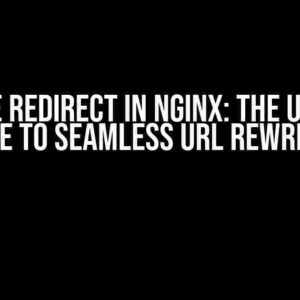Are you tired of staring at blank spaces where your API-generated images should be? Are you frustrated by the seemingly innocent icons that pop up instead of the images you need? Don’t worry, you’re not alone! In this article, we’ll delve into the common issues that might be causing this problem and provide a comprehensive solution to help you get those images loading in no time.
Understanding the API Limitations
Before we dive into the troubleshooting process, it’s essential to understand the API limitations that might be affecting your image loading. You’ve already checked the API, and there’s no limit, but there might be other factors at play:
- Rate Limiting: Even if the API doesn’t have a strict limit, there might be rate limiting in place to prevent excessive requests. This can cause images to fail to load or load slowly.
- Cache Control: Some APIs implement cache control mechanisms to reduce the load on their servers. This can result in images being served from cache instead of being generated on the fly.
- Image Size and Quality: Large or high-quality images can take longer to load, causing issues with your application. Make sure you’re requesting images in a suitable size and quality for your use case.
Debugging and Troubleshooting
Now that we’ve covered the potential API limitations, let’s get down to business and start debugging!
Step 1: Inspect the API Response
Use your favorite browser’s developer tools or a tool like Postman to inspect the API response. Check the following:
- Status Code: Ensure the API is returning a 200 status code, indicating a successful response.
- Response Headers: Look for headers like `Content-Type` and `Content-Length` to verify the response is correct.
- Response Body: Check the response body to ensure it contains the expected image data.
Step 2: Verify Image URLs
Check the image URLs generated by the API:
- URL Structure: Ensure the URL structure is correct and follows the API’s documentation.
- Image File Extension: Verify the image file extension (e.g., .jpg, .png, .gif) is correct and matches the API’s documentation.
- Image URL Encoding: Make sure the image URL is properly encoded to handle special characters or spaces.
Step 3: Test Image Loading
Test the image loading by:
- Directly Accessing the Image URL: Try accessing the image URL directly in your browser to see if it loads.
- Using a Different Browser or Device: Test image loading on different browsers or devices to rule out browser-specific issues.
- Checking for CORS Errors: Verify there are no CORS (Cross-Origin Resource Sharing) errors blocking the image loading.
Optimizing Image Loading
Once you’ve identified and fixed any issues, it’s time to optimize image loading for a better user experience:
Lazy Loading
Implement lazy loading to reduce the initial load on your application and improve performance:
<img src="placeholder.jpg" data-src="https://api.example.com/image?" alt="Image">
Use a JavaScript library like Lazy Load or Intersection Observer to load images only when they come into view.
Image Compression
Compress images to reduce their size and improve loading times:
| Image Type | Compression Tool |
|---|---|
| JPEG | TinyPNG or ImageOptim |
| PNG | TinyPNG or ImageOptim |
| GIF | Gifsicle or ImageOptim |
Use a combination of compression tools and techniques to optimize your images for web use.
Caching and CDN
Implement caching and use a Content Delivery Network (CDN) to reduce the load on your application and improve image loading times:
- Cache-Control Headers: Use cache-control headers to instruct browsers and CDNs to cache images for a specified period.
- CDN Integration: Integrate a CDN like Cloudflare or Amazon CloudFront to distribute images across multiple servers and reduce latency.
Conclusion
By following this step-by-step guide, you should be able to identify and fix the issues preventing your API-generated images from loading. Remember to optimize image loading using lazy loading, compression, and caching techniques to provide a better user experience. If you’re still struggling, don’t hesitate to reach out to the API support team or seek help from a developer community.
<img src="https://api.example.com/image?" alt="Image">
With patience and persistence, you’ll be displaying those images in no time!
Here are the 5 Questions and Answers about “Images I’m generating from an API doesn’t seem to load anytime I try and work on my code only icons pop up and I checked the API if there was no limit”
Frequently Asked Question
Fed up with seeing icons instead of images? Let’s troubleshoot the issue together!
What are the possible reasons why images from the API aren’t loading?
There could be several reasons why images aren’t loading, such as incorrect API endpoint, invalid API key, rate limiting, or even a simple typo in the URL. Make sure to double-check the API documentation and your code for any mistakes.
Could the issue be related to the API’s rate limiting?
Even if you’ve checked the API’s rate limiting, it’s still possible that you’re hitting the limit without realizing it. Check the API’s documentation on rate limiting and see if there’s a way to monitor your requests. You might need to implement a wait time between requests or use a caching mechanism.
What if I’m using the correct API endpoint and key, but still getting icons instead of images?
In this case, the issue might be with the image URL itself. Make sure the URL is correct and that the image exists. Also, check if the API returns a placeholder image or an icon when the requested image doesn’t exist.
How can I debug the issue and find the root cause?
Use your browser’s developer tools to inspect the network requests and responses. Check the URL of the image request and the response code. If you’re getting a 404 or 403 error, it might indicate a problem with the image URL or API access. You can also try logging the API responses to see if there’s any error message or hint.
What’s the best practice to avoid this issue in the future?
To avoid this issue in the future, make sure to thoroughly test your API requests and responses. Also, implement a robust error-handling mechanism to catch any unexpected errors or responses. Finally, always read and follow the API documentation carefully to avoid any misunderstandings.






